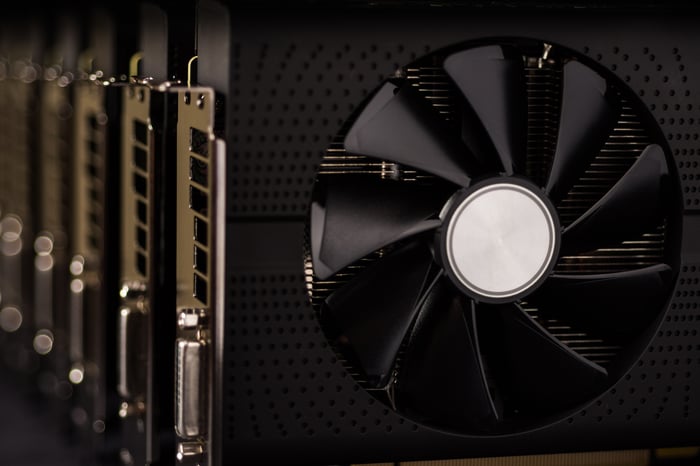When examined over long stretches, history shows that Wall Street's major indexes head decisively higher. But over shorter timelines, the directional movement in stocks is no more certain than a coin flip.
Over the trailing-two-year period, the Dow Jones Industrial Average, S&P 500, and Nasdaq Composite have all surged to new highs, plummeted into a bear market, and are all, once again, pushing higher. When Wall Street whipsaws investors, they have a tendency to seek out time-tested businesses. In recent years, the answer for investors has been to gravitate to stocks enacting splits.

Image source: Getty Images.
A stock split is an event that lets a publicly traded company alter its share price and outstanding share count without having any impact on its market cap or operating performance. It's a purely cosmetic move that can make shares more nominally affordable for retail investors, as with a forward-stock split, or can boost a company's share price to meet minimum listing standards for a major exchange, as often occurs with a reverse-stock split.
For all intents and purposes, most investors are seeking out companies enacting forward splits. The reason high-flying stocks are splitting their shares to make them more nominally affordable for everyday investors is usually because they're executing on their strategic initiatives and out-innovating their competition.
Since the start of July 2021, eight brand-name companies have conducted forward stock splits (listed chronologically):
- Nvidia (NVDA 1.28%): 4-for-1 split in July 2021
- Amazon (AMZN 1.62%): 20-for-1 split in June 2022
- DexCom (DXCM -0.78%): 4-for-1 split in June 2022
- Shopify (SHOP 1.48%): 10-for-1 split in June 2022
- Alphabet (GOOGL 0.54%) (GOOG 0.51%): 20-for-1 split in July 2022
- Tesla (TSLA 0.04%): 3-for-1 split in August 2022
- Palo Alto Networks (PANW 2.48%): 3-for-1 split in September 2022
- Monster Beverage (MNST 0.14%): 2-for-1 split in March 2023
While these are all top-notch businesses with well-defined competitive advantages, not all stock-split stocks are alike. In August, one historically cheap stock-split stock stands out as a surefire buy for opportunistic investors, while another is facing a mountain of headwinds and would be best avoided.
The stock-split stock to buy hand over fist in August: Amazon
The stock-split stock that patient investors can confidently buy hand over fist in August is none other than e-commerce leader Amazon.
Although shares of the company have bounced back strongly in 2023, Amazon is still well below its all-time high, set in November 2021. The primary concern skeptics share is the belief that the U.S. economy will slow in the not-too-distant future. Despite second-quarter U.S. gross domestic product expanding at a faster pace than Wall Street had expected, numerous predictive tools are screaming that a recession is on the horizon.
Amazon generates most of its revenue from its world-leading online marketplace. Since retail sales are cyclical, a recession would likely lead to revenue stagnation or declines for the company's top sales segment.
But the most important thing to understand about Amazon is that there's a big difference between revenue and cash flow. While it does bring in a lot of revenue from online retail sales, the margins associated with e-commerce are small. Comparatively, a handful of Amazon's other operating channels generate the bulk of its cash flow, despite not accounting for as much of its net sales.
Amazon Web Services (AWS) can easily be labeled the company's most important operating segment. Even though AWS only accounts for a sixth of Amazon's net sales, it regularly produces 50% to 100% of the company's operating income. Enterprise cloud infrastructure service spending is still in the early stages of ramping up, and AWS currently controls almost a third of the global cloud infrastructure service market share.
Subscription services is another key segment, led by Prime. Amazon surpassed 200 million Prime subscriptions in April 2021 but hasn't updated this figure since. Considering that year-over-year subscription services revenue growth hasn't dipped below 13% on a currency-neutral basis in any of the past six quarters (through the end of March), it's a good bet that Amazon's pricing power and aggregate Prime subscriber count are climbing.
The point is that the segments vital to Amazon's operating cash flow are still growing by a sustained double-digit percentage. Even if online retail sales weaken, it won't have much of an impact on the operating metric that truly matters to Amazon.
During the 2010s, Amazon closed out every year with a price-to-cash-flow ratio of between 23 and 37. Based on Wall Street's consensus estimate, investors can scoop up shares of Amazon right now for a multiple of 17x forecast 2023 cash flow, less than 13x forward-year cash flow, and just 9x projected cash flow in 2026. Amazon stock is cheaper now than it's ever been as a publicly traded company.

Image source: Getty Images.
The stock-split stock to avoid like the plague in August: Nvidia
However, not all stock-split stocks are going to deliver for their shareholders. Out of the eight high-profile companies to have split their shares since July 2021, it's graphics processing unit (GPU) giant Nvidia that's worth avoiding like the plague in August.
Just as all great businesses have headwinds to contend with, stocks to avoid have catalysts that can push them higher. For Nvidia, there's no bigger catalyst than the artificial intelligence (AI) revolution. Based on an estimate from PwC, AI can provide a $15.7 trillion lift to the global economy by 2030.
While there's plenty of excitement with regard to AI software and system solutions, Nvidia's role is primarily as the backbone of high-compute data centers. It provides the lion's share of the GPUs currently deployed in AI-driven data centers. Though additional competition is undoubtedly coming, Nvidia's first-mover advantages and superior GPUs have put it in the driver's seat.
Unfortunately, even first-mover advantages in AI may not be enough to support the company's otherworldly valuation.
One problem for Nvidia is that history isn't on its side. Every next-big-thing investment or hot growth trend over the past 30 years has gone through a boom-then-bust phase. I'm talking about the internet, genome decoding, cannabis, 3D printing, blockchain technology, the metaverse, and much more. Though companies involved in next-big-thing investments can be wildly successful over the long run, history has shown that Wall Street and investors tend to overestimate the adoption of new technology.
Supply chain constraints are another concern for Nvidia. As I discussed earlier this week, the limited supply of high-bandwidth memory and chip on wafer on substrate are holding back giants like Nvidia from truly taking advantage of AI euphoria.
Another potential problem for Nvidia is that U.S. regulators are considering even more stringent standards regarding shipments of its AI GPUs to China. Last year, regulators restricted the export of Nvidia's high-powered, AI-inspired A100 and H100 GPUs to China, which inspired the company to develop the slower A800 and H800 GPUs.
But even these toned-down solutions may, eventually, be restricted. When initial restrictions were put in place last year, Nvidia warned it could lose up to $400 million in quarterly sales.
Lastly, valuation is a front-and-center concern. If U.S. economic growth does slow in the second half of 2023 or early 2024, investors are going to be far less willing to pay more than 170 times cash flow and 243 times trailing-12-month earnings for shares of the company.





